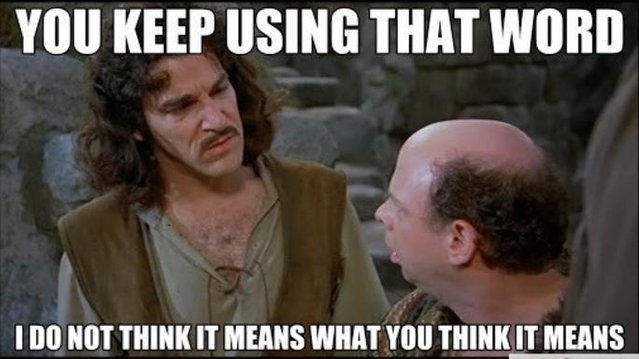Quality Cannot Exist Without Standards

"Quality" is a term that gets tossed around very loosely on Steemit.
Yet, for being such a poorly used word, the entire culture surrounding Steemit is based on it. A quick search for the word "quality" in the Steemit whitepaper brings up these results:
A means of getting high
qualityanswers to personalized questions.
The elected witnesses are presumably trusted by those who have a vested interest in the
qualityof the feed.
The challenge is how to judge the relative
qualityand quantity of work that individuals provide and to do so in a way that efficiently allocates rewards to millions of users. This requires the introduction of a scalable voting process. In particular, authority to allocate funds must be as distributed and decentralized as possible.
The more competitive the market becomes, the more difficult (higher
qualityor quantity) it becomes to earn the same payout.
Requiring a relatively large fee ($1.00) to sign up new users will naturally force anyone offering free accounts to vet the
qualityand uniqueness of each account before registering them with the blockchain.
A social network can maximize the value extracted from a set of content by maximizing the quantity and
qualityof connections. Curating content is expensive and time consuming, while near impossible for computers to perform in the absence of links. Steem rewards users who are among the first to find and identify new content. By incentivizing curation, the Steem network is able to use automated algorithms to extract the most valuable information from a massive amount of content.
Now ask yourself: how much of this has worked out the way Steemit Inc. intended?
Obviously Steemit Inc did not count on the creation of bid bots or many of the other automated services that now exist. With the ability to buy One's way into the Trending category, the need or use of algorithms to sort content based on curation is pointless. Curation is practically a joke, as it does not actually incentivize finding "quality" content, but rather it incentivizes those to find content they know will earn a large upvote, regardless of it's quality. This then further exacerbates the problem with the Trending category, as people will upvote posts they know the author is likely to promote via bid bots.
A similar search in the whitepaper for the word "Standard" returned only one result, which honestly seems to have nothing to do with quality:
Micropayment supporters believe that a simplified implementation can minimize the intrusiveness of micropayments and improve user experience, but their argument only creates double
standardsfor the decision making process.
Hmm. So it seems that Steemit Inc had no intentions of defining any standards to which a "quality" post is to be held. The only thing suggested is that "quality" posts will earn more because people will upvote "quality". Which obviously has not worked out to be true.
According to the dictionary, quality is something that is defined by standards.
qual·i·ty /ˈkwälədē/ noun: quality; plural noun: qualities
- the standard of something as measured against other things of a similar kind; the degree of excellence of something.
These standards are easily identifiable and recognizable by anyone who deems a particular thing as being a "quality" item. Every industry that produces a thing has a set of standards to which they must comply, at the legal level, as well as in the market. For example, here are some of the standards set forth by the Society of Professional Journalists:
Journalists should:
- Take responsibility for the accuracy of their work. Verify information before releasing it. Use original sources whenever possible.
- Remember that neither speed nor format excuses inaccuracy.
- Provide context. Take special care not to misrepresent or oversimplify in promoting, previewing or summarizing a story.
- Gather, update and correct information throughout the life of a news story.
- Be cautious when making promises, but keep the promises they make.
- Identify sources clearly. The public is entitled to as much information as possible to judge the reliability and motivations of sources.
- Consider sources’ motives before promising anonymity. Reserve anonymity for sources who may face danger, retribution or other harm, and have information that cannot be obtained elsewhere. Explain why anonymity was granted.
- Diligently seek subjects of news coverage to allow them to respond to criticism or allegations of wrongdoing.
- Avoid undercover or other surreptitious methods of gathering information unless traditional, open methods will not yield information vital to the public.
- Be vigilant and courageous about holding those with power accountable. Give voice to the voiceless.
- Support the open and civil exchange of views, even views they find repugnant.
- Recognize a special obligation to serve as watchdogs over public affairs and government. Seek to ensure that the public’s business is conducted in the open, and that public records are open to all.
- Provide access to source material when it is relevant and appropriate.
- Boldly tell the story of the diversity and magnitude of the human experience. Seek sources whose voices we seldom hear.
- Avoid stereotyping. Journalists should examine the ways their values and experiences may shape their reporting.
- Label advocacy and commentary.
- Never deliberately distort facts or context, including visual information. Clearly label illustrations and re-enactments.
- Never plagiarize. Always attribute.
Unfortunately, Steemit has no way to enforce these standards via "incentivized monetization".
Besides, no one on Steemit purports to be a professional journalist. They're just bloggers, man. OK, here's a list of standards for what is considered a high quality blog post according to impactbnd.com:
People prefer content that is relate-able. Use a writing style that matches the way your [audience] persona speaks within their industry and to their colleagues.
Once you have an audience, ask for feedback. Let them tell you what they want and don't want to hear from you.
Once you've figured out who your audience is and what they want, you have to follow-through and provide valuable content. Valuable in this context means to:
Be original. You want to create [original] content that stands out from the crowd and adds to the conversation, instead of repeating old news.
Be Actionable. When someone lands on your blog, they are looking to solve a problem or learn more about something. Oftentimes they are looking for a solution that they can implement immediately.
Write Content That’s Easy to Read. Content that isn't easy to read simply doesn't get read.
A high quality blog post also Includes
- Eye-catching titles.
- Accurate information
- Search engine optimization
- Relevance
- Links to other relevant information
- Call to action
- Regular updates
Summary
Once again, incentivizing Steemit users to upvote quality content apparently does not work as very few of these standards are met by bloggers on Steemit.
Also, who's supposed to be judging the "quality" of a Steemit post, anyway? Interestingly enough, almost all the content on Steemit is about Steemit and is geared towards Steemit users (the author of this article is guilty of this). This is a bit ridiculous as it would be like every link on Google was about Google. Steemit authors need to realize that the articles they are writing come up in Google search results and could very well be the first thing someone outside of Steemit sees as they learn what Steemit is. What kind of impression would they have?
Stay tuned
In the next part in this series I'll write more about Use Case Scenarios and how they relate to quality content, as well as some tips at the end for writing better blog posts. I also have some ideas on how Steemit content can be organized more efficiently. But before I write my next posts I want to hear from you. Do you have a gripe about the quality on Steemit? Do you have a solution? Leave me a comment and let me know your ideas on how we can make Steemit a better place for everyone, non-Steemians included.
Contact Me
I'm "Mike-A" on the Artopium Discord server.
Or visit my website mike.artopium.com
My Projects
SteemAX

@ArtTurtle

@Artopium


Thank you artopium! You've just received an upvote of 100% by @ArtTurtle!
Learn how I will upvote each and every one of your art and music posts
Please come visit me as I've updated my daily report with more information about my upvote value and how to get the best upvote from me.
Thanks for the post. Yes I'm aware of these, as do many curator-types out there, although I'd say many would miss the finer points of journalism. It's just that many haven't bother over the past year since the economic incentive is broken. Hence the proposal to encourage the rewarding of time-consuming/effortful content creation and also stimulate the curation economy (that includes all of us and dedicated curation services). The floor should increase from thereon.